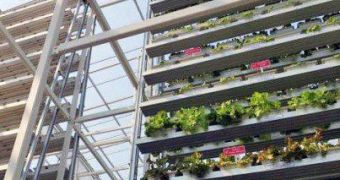Only recently, Singapore has witnessed the opening of a vertical farm which supposedly produces half a ton of vegetables on a daily basis.
As the name thoroughly suggests, this innovative farm is basically a tower which doubles as a greenhouse, meaning that the growing vegetables are carefully stacked one on top of the other.
Tree Hugger informs us that each of the floors on which vegetables are being grown can rotate around a fixed axis located in the center of the farm.
This means that productivity is significantly increased simply by allowing the developing plants to make the most out of whatever sunlight is available at various times of the day.
Given the predicted urban expansion, such vertical farms could really come in handy in the future, seeing how they can satisfy food demands while eliminating the need to turn several natural habitats into agricultural lands.
Needless to say, this also helps with ongoing conservation efforts.
The official website for Sky Greens (i.e. the company behind this innovative project) describes this vertical farm as follows:
“[It's the] World’s first low carbon hydraulic water-driven, tropical vegetable urban vertical farm, using green urban solutions to achieve enhanced green sustainable production of safe, fresh and delicious vegetables, using minimal land, water and energy resources.”
Furthermore, “The A-Go-Gro vertical systems which are 9m in height, housed in protected-outdoor green houses, allow tropical leafy vegetables to be grown all year round at significantly higher yields (than traditional growing methods) that are safe, of high quality, fresh and delicious.”
Apparently, the people working at this farm constantly monitor the plant's intake of soil nutrients, fertilizers and water, their goal being to make sure the vegetables they sell to the people in Singapore can satisfy the strictest of demands.
Should things go as planned, this 30-foot-tall vertical farm could potentially quadruple its production rates as early as next year.

 14 DAY TRIAL //
14 DAY TRIAL //